Sunday, June 26, 2011
Cutting Huge Bench-Size Dovetails
Last year while building a series of Roubo benches I discovered a quick and straightforward method for cutting the large half-lap dovetail that joins the end cap to the front laminate.
Soon after I dropped a line to Megan Fitzpatrick, managing editor at Popular Woodworking Magazine to see if she was interested in the article. My intention was to publish the info right here, but I thought it would be nice if the technique reached a wider audience, so I pitched the idea to Megan first. She agreed to the article and I got busy writing and sawing.
The article appears in this month's Popular Woodworking Magazine. If you're about to build a bench, or something else with big dovetails, I think its worth reading. The method eliminates, without any compromises, any tedious or skill-demanding chisel work. I've used this technique several times since I first discovered it, and it's worked great every time.
Categories
Split-Top Roubo,
Tail Vise,
Technical Questions
Monday, June 20, 2011
Woodworking Machinery Renaissance
It's been said before, we are living in a woodworking machinery Renaissance (insert sound of a turntable needle scratching a record here).
Okay, that's mostly untrue. Manufacture of fine, cast iron woodworking machinery in America has all but died. There were once thousands (yes, that many--have doubts? see this) of companies manufacturing heavy, cast-iron machines all over the country. The choices were astounding. Today I think I could count on one hand those companies who are still at it. Northfield Machinery Builders, is one that is still alive and well, for example. Two of my old machines are 50+-year old Northfields that I bought from a high-school auction in Minneapolis.
Why did I say mostly untrue? Dozens of cabinet and furniture making companies are closing their doors, either closing completely or selling off the assets and setting up shop on the other side of the planet. And herein lies the machinery Renaissance. Many of these companies have been in business for decades, and some going on a century or more. The machines they outfitted their shops with back then are in most cases, still running strong. They are widely available and generally inexpensive through auctions and sales.
Over the past year I have been slowly replacing my modern, Asian-made machines with older, American-made machines. In most cases, I've been able to obtain these machines for much less than a comparable modern machine. And they are better machines in every way. I say this without hesitation.
Back when Americans were making machinery with pride, the folks at the drafting table knew what they were doing. They actually designed machines to work properly, keep settings, and last. They didn't simply use an established blueprint, start up the assembly line, and bank on good sales and repeat business as a predetermined given. The bottom line wasn't the at the top of the list. Making quality machines was.
Sound familiar? It's the same philosophy that's driving the current American hand-tool manufacturers and the very real hand tool Renaissance. Tom Lie-Nielsen, Konrad Sauer, Dave Jeske, Joel Moskowitz (and many more) have dedicated themselves to the notion of making things here, and making them with lasting function and beauty as the driving force.
Since last September I've replaced my jointer, multiple drill presses, and I have an 18" planer, 24" cast-iron scroll saw, small shaper, and a 1916 auto-reciprocating Greenlee mortiser waiting in the wings. For every one of these machines I paid less (and not just a little) than the smaller, cheaper, inferior machines they replace or will replace, and when I sell off my "old" machines, I'll have money in my pocket.
All of these machines were found within a half-day drive of my shop, and most of them less than an hour away.
We may not be able to purchase new, high-quality, American-made machines anymore (I wish it wasn't so), but from my perspective as a blended woodworker, we are living in a sort of machinery renaissance. And I can't think of a better place for these machines to end up than the shops of passionate amateur woodworkers who will carry on the craft and make real, lasting furniture with these machines instead of purchasing curb fodder that is modern factory furniture. After reading Christopher Schwarz's latest tome, The Anarchist's Tool Chest I'm convinced that I'm right in searching out these old, American-made gems and putting them to good use in my shop. If you're not sure what I'm talking about, read the book. It's his best to date.
Thursday, June 16, 2011
John's Apprentice Bench Slideshow
John's bench was officially done about two months ago. Last night we finally got a few moments to make up this slideshow.
John's been woodworking since he was about 8 years old, when he built his first workbench, completely on his own, with scrap wood and an old clamp-on Stanley vise. His first project was a box to hold a cross, complete with a french-fitted cutout made from cardboard.
John, age 8, using my Lie-Nielsen 164 on my bench (he's standing on a stepstool).
John's first bench.
Making the French-fitted box insert with a chip-carving knife.
So last fall, after WIA, when John told me he wanted to make something "serious" and suggested a workbench with our vises, I was thrilled.
As John's teacher, I was extremely satisfied with the outcome of his bench. Some of you may be wondering how much he actually did on his own (he'll be 17 next week). The answer is, a lot.
Instead of giving him a crash course in woodworking, I walked him through each step of making the bench as if I were making it. Need to cross cut wood to length? I'd grab a handsaw and do the first cut. Now you imitate. I would make corrections and explain the "why's" along the way, with some safety lessons mixed in. John jointed and planed (with both hand work and machines) all the lumber for the bench, with me sometimes doing outfeed duties, feeding him the piece for another pass. This way he got a lesson and practical experience for every part of the build. In the end, I did almost nothing during the build other than show him what to do, and perform the first cut or operation.
I did cut the large dovetail that joins the front laminate to the end cap. I needed to illustrate the technique for an article I wrote for the August 2011 issue of Popular Woodworking Magazine. It's a great technique I discovered by chance last year while installing a Benchcrafted Tail Vise. It makes cutting huge dovetails easy and fun, and it's crazy precise.
On the last day of the build I was working in a another building when John stepped in holding the pin for his parallel guide, with a nicely turned ebony handle attached. It had been about three years since I helped him do a couple turnings on the lathe. Then out of the blue, this. It was a great ending to the project, a moment I'll remember for a long time.
Tuesday, June 14, 2011
See Us At The Lie-Nielsen Open House July 15-16
As we mentioned earlier we'll be traveling to Warren, ME for Lie-Nielsen Toolworks' 30th Anniversary Open House July 15-16.
More info HERE.
This will be our first trip to this part of the country. If you're interested in our products, please stop by to try out everything we offer. We'll have a complete bench outfitted with our vises so you can give the wheels a spin and see how they work. Lie-Nielsen is also an authorized Mag-Blok dealer.
We also hope to have our new Moxon vise in production by that weekend, and we'll have one there to test out. The Moxon vise is THE answer to comfortable backsaw work at the bench.
This event is shaping up to be one to remember. In addition to the numerous tool makers that will be present (and hats off to Lie-Nielsen for creating such a wonderfully convivial atmosphere among us toolmakers), several top furniture makers will be in attendance. Garrett Hack, Christian Becksvoort, Peter Follansbee and many more.
Oh, and don't forget the lobster bake. As native corn-country folk, this is something we don't want to miss.
See you there!
Tuesday, June 7, 2011
New Benchcrafted Website
After some months of work the new website is up. It's largely cosmetic, so no real surprises. It is however updated in many ways and hopefully more user friendly. You probably noticed the blog has been redesigned as well. Hopefully its all easier to read, and easier to navigate.
The Gallery page has some new videos on it as well.
We've also added a dedicated Downloads page to make instructions and templates easy to find.
And don't forget to read our FAQ, where we thought it made sense to move the instructional videos.
Saturday, June 4, 2011
A Smoothing Plane Trick and Some Amazing Dovetails
Last week I glued the small chest using Old Brown Glue. It's my first time using the stuff and I have to say I like it. One thing I don't care for is the smell however. When I warmed the glue in warm water then cracked open the lid, I had the same feeling when you start rooting through last night's leftovers first thing in the morning and mistakenly open the Tupperware of broccoli. To me it smells very little like hot hide glue. Not that I enjoy that odor, but its not off putting. In fact, when I do mix up a batch of hot glue I'm immediately taken back in time to some of the more intense sessions of luthiery work. It's an interesting sensation.
Nevertheless, I'm probably going to move towards using this glue for all my furniture making. The main reasons are convenience and conservation. The longer open time of OBG is important for gluing certain long-assembly joints like the dovetails in this chest. Even yellow glue is too quick for my tastes in this case. Yellow glue does not stick to itself, making future repairs extremely difficult. Hide glue just needs to be rehydrated to reactivate it. One thing I noticed right away about OBG that I did not expect. Once it cools and starts to cure it gets super tacky just like hot hide. I love this feature, and it instills confidence. I never experienced this with Franklin's liquid hide glue, which I've used now and then.
After the glue cured (I let it sit overnight) I had the task of planing the joints flush. Planing large unsupported panels after assembly is always tricky. I did cut these dovetails so the joints were slightly proud, but I always find some long grain planing that needs to take place post-assembly. And that's where vibration comes into play. Not in the plane, but in the panel. There is also the issue of the panel flexing to concave under planing pressure and preventing the iron from engaging.
So I clamped the chest to the bench in the tail vise and inserted a wide board between the front and back of the chest. The board is just a tad longer than the inside width of the chest. The brace introduced a very slight convex bow to the outside of the panels, allowing my smoothing plane to ride the arch easily. No chance of the cut disengaging from the panel as it deflected away from the sole. The brace also prevented any vibration. It was as if I was working the panel directly on the bench top.
Sighting down the panel's edge the slight outward bow can be seen.
Once the corners were planed flush (the end panels were short enough not to need the brace trick) and the joints revealed, the accuracy of the Bridge City JMP became evident once again. I was simply blown away by the quality of the joints. Every one was dead on. No gaps. Simply put, the joints were as close to perfect as possible. If you're into that sort of thing (I like tight joints too, but I don't obsess about them), the JMP won't disappoint. All I did was make careful scribe lines (see that in the video in the previous "Personal Work" post) and then line up those scribe lines right the blade's edge on my zero-clearance tables on the JMP. That's it.
Subscribe to:
Posts (Atom)
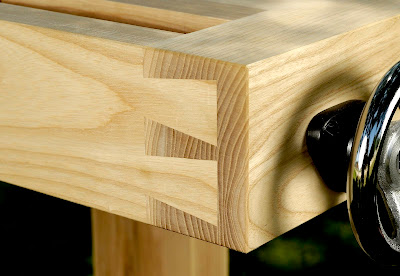


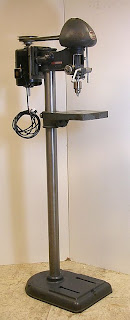




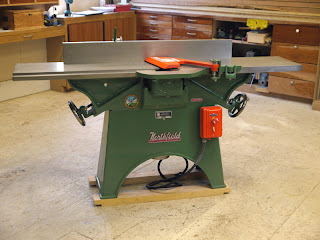





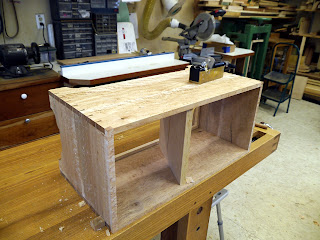
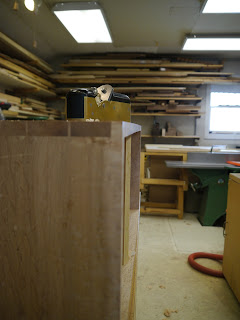
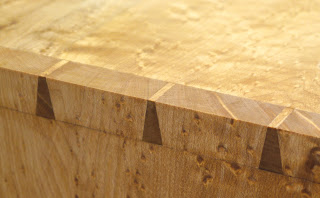
 Made in the U.S.A.
Made in the U.S.A.